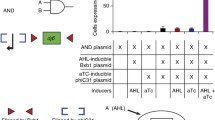Abstract
In nature the DNA contained in each cell of an organism, is in fact a memory map that, through the transcription of its genes, describes the unique characteristics of the individual. Similarly in an artificial embryonic cell, used to construct electronic systems, a memory map and its relevant gene also describes and determines the functionality of each cell and, collectively, the entire system. This paper proposes a new variable size memory map based on a novel and efficient gene selection algorithm that no longer uses the hitherto common address decoding approach to access some fixed memory space. Instead, it applies the principle of cyclic metamorphic gene selection of the artificial DNA memory. A further benefit of the approach is that the functionality of the system can also be easily altered through genetic operators or variable memory space environment for enhanced behaviour. It is suitable therefore for the implementation of GA processes.












Similar content being viewed by others
References
E. Sanchez et al., Phylogeny, ontogeny, and epigenesis: three sources of biological inspiration for softening hardware, in Evolvable Systems: From Biology to Hardware, ed. by Tetsuya Higuchi, Masaya Iwata. Proceedings of the First International Conference, Tsukuba, Japan, October 7–8, 1996. Lecture Notes in Computer Science, vol. 1259 (Springer-Verlag, 1996), pp. 35–54
D. Mange, M. Sipper, A. Stauffer, G. Tempesti, Toward robust integrated circuits: the embryonics approach. Proc. IEEE 88(4), 516–541, (2000)
D. Mange, E. Sanchez, A. Stauffer, G. Tempesti, P. Marchal, C. Piguet, Embryonics: a new methodology for designing field-programmable gate arrays with self-repair and self-replicating properties. IEEE Trans. Very Large Scale Integration Syst. 6(3), 387–399 (1998)
L. Prodan, D. Mange, G. Tempesti, The embryonics project: specifications of the muxtree field programmable gate array. Technical Report No. IC/2002/03, In-Ecublens, CH-1015 Lausanne, Switzerland, pp. 1–23, January 2002
C. Ortega-Sanchez, A.M. Tyrrell, MUXTREE revisited: embryonics as a reconfiguration strategy in fault-tolerant processor arrays, in Evolvable Systems: From Biology to Hardware, ed. by Moshe Sipper, Daniel Mange, Andrés Pérez-Uribe. Second International Conference, Lausanne, Switzerland, September 23–25. Lecture Notes in Computer Science, vol. 1478 (Springer-Verlag, 1998), pp. 206–217
N.J. Macias, L.J.K. Durbeck, Adaptive methods for growing electronic circuits on an imperfect synthetic matrix. J. Biosyst. 73(3), 173–204 (2004)
G. Tempesti, D. Mange, E. Petraglio, A. Stauffer, Y. Thoma, in Developmental Processes in Silicon: An Engineering Perspective, ed. by Carl K. Chang. Proceedings of the 5th NASA/DoD Workshop on Evolvable Hardware, Chicago, USA, July 9–11, pp. 255–264, 2003
C. Ortega-Sanchez, A.M. Tyrrell, Reliability analysis in self-repairing embryonic systems, in Evolvable Hardware, ed. by Carl K. Chang. Proceedings of The 1st NASA/DoD Workshop on, Pasadena, CA, USA, July 19–21, pp. 120–128, 1999
A.M. Tyrrell, G. Hollingworth, S.L. Smith, Evolutionary strategies and intrinsic fault tolerance, in Evolvable Hardware, ed. by Carl K. Chang. Proceedings of The 3rd NASA/DoD Workshop on, Long Beach, CA, USA, July 12–14, pp. 98–106, 2001
C. Ortega-Sanchez, A.M. Tyrrell, Fault-Tolerant Systems: The Way Biology Does it!, ed. by Peter Milligan. Proceedings of the 23rd Euromicro Conference, Budapest, Hungary, September 1–4, (IEEE CS Press, 1997), pp. 146–151
X. Zhang, G. Dragffy, A. G. Pipe, Q. M. Zhu, Partial-DNA supported artificial-life in an embryonic array, in Engineering of Reconfigurable Systems and Algorithms, ed. by Toomas P. Plaks. Proceedings of the International Conference on, Las Vegas, Nevada, USA, June 21–24 (CSREA Press, 2004), pp. 203–208
POEtic project webpage: http://www.poetictissue.org
C. Ortega-Sanchez, A.M. Tyrrell, A hardware implementation of an embryonic architecture using virtex FPGAs, in Evolvable Systems: From Biology to Hardware, ed. by Tetsuya Higuchi, Masaya Iwata, Weixin Liu. Proceedings of the Third International Conference, Edinburgh, Scotland, UK, April 17–19, 2000. Lecture Notes in Computer Science, vol. 1801 (Springer Verlag, London, 2000), pp. 155–165
X. Zhang, G. Dragffy, A.G. Pipe, N. Gunton, Q.M. Zhu, A reconfigurable self-healing embryonic cell architecture, in Engineering of Reconfigurable Systems and Algorithms, ed. by Toomas P. Plaks. Proceedings of the International Conference on, Las Vegas, Nevada, USA, June 23–26, 2003 (CSREA Press, 2003), pp. 134–140
D. Mange, M. Goeke, D. Madon, A. Stauffer, G. Tempesti, S. Durand, P. Marchal, P. Nussbaum, Embryonics: a new family of coarse-grained field-programmable gate array with self-repair and self-reproducing properties, in Circuits and Systems, ed. by Eduardo Sanchez, Marco Tomassini. Proceedings of 1996 IEEE International Symposium on Towards Evolvable Hardware. Lecture Notes in Computer Science, vol. 1062 (Springer-Berlin, 1996), pp. 197–220
Author information
Authors and Affiliations
Corresponding author
Rights and permissions
About this article
Cite this article
Samie, M., Farjah, E. & Dragffy, G. Cyclic metamorphic memory for cellular bio-inspired electronic systems. Genet Program Evolvable Mach 9, 183–201 (2008). https://doi.org/10.1007/s10710-008-9056-z
Received:
Revised:
Accepted:
Published:
Issue Date:
DOI: https://doi.org/10.1007/s10710-008-9056-z




